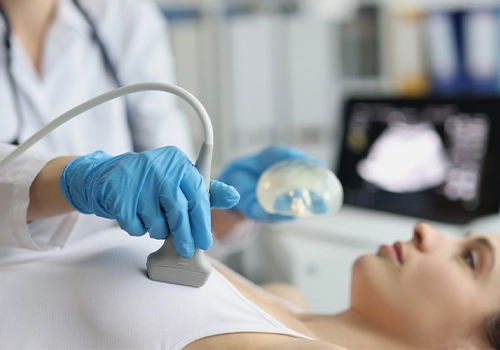Introduction
Breast augmentation, also known as breast implant surgery or breast enhancement, is a popular cosmetic procedure that aims to enhance the size and shape of a woman’s breasts. this comprehensive guide will provide you with all the essential information you need before planning to have this surgery in Iran with “Dr. Maadico”.
What is Breast Augmentation?
Breast augmentation, also known as augmentation mammoplasty, is a cosmetic surgery that involves placing breast implants under the breast tissue or chest muscles to increase the size, shape, or fullness of the breasts.
Breast augmentation can improve the appearance and self-confidence of women who are unhappy with their natural breast size or shape, or who have lost breast volume due to pregnancy, weight loss, or aging. Breast augmentation is not a treatment for breast cancer or sagging breasts (ptosis), and it does not prevent breast sagging over time. Breast enhancement is a personal decision that should be made after consulting with a qualified plastic surgeon and understanding the risks and benefits of the procedure.

Types of Breast Implants
Breast implants are medical devices that are used to increase the size or change the shape of the breasts. There are two main types of breast implants: saline and silicone.
- Saline implants are filled with sterile salt water, while silicone implants are filled with a gel-like substance. Both types of implants have a silicone shell that can vary in size, shape, texture, and thickness.
Breast implants can be placed either under the chest muscle (sub-muscular) or over the chest muscle (sub-glandular). The placement of the implants depends on several factors, such as the amount of breast tissue, the desired appearance, and the surgeon’s preference.
Other implants used to augment the size and volume of the women’s breast includes:
- Round Breast Prosthesis Round breast prostheses have a spherical appearance and are filled with softer materials. These implants move naturally within the breasts as you move, resulting in a beautiful and natural look. They can be precisely positioned within the breasts using an armpit incision.
- Smooth Breast Implant The silicone rubber shell of the breast prosthesis is smooth, slippery, and glossy. This allows it to move easily within the tissue membrane that forms around the implant (capsule) and prevents it from adhering to the surrounding body tissue. Using an implant with a smooth surface also lowers the risk of capsular contracture.
- Texture Breast Prosthesis The silicone shell around textured implants is thicker than that of the smooth type and has a texture akin to soft rubber sandpaper. These implants are attached to the surrounding membrane of the tissue and are immobile. Textured implants can assume a teardrop shape and are more noticeable in lean patients with less breast tissue when placed above the muscle.
- Adhesive Breast Prostheses (Contact adhesive breast form)_ This kind of prosthesis attaches directly to the chest wall and is a suitable option for individuals who have undergone a mastectomy, or breast removal. This type of prosthesis requires regular maintenance, which includes daily cleaning and preventing dirt and dust from adhering to its adhesive surface to preserve its stickiness. Using a bra with this prosthesis is simple and convenient.

Breast Enlargement through Fat Transfer
In this procedure, breast size is naturally increased by injecting fat taken from the patient’s body into the breast tissue. Fat is extracted from various parts of the patient’s body through liposuction and subsequently purified before being injected into the breasts. This method enables breast volume enhancement without the use of implants.
- Fat transfer is a suitable option for individuals in good general health who do not smoke. It’s essential to note that with this method, breast size typically increases by 1 to 2 sizes.
- If you desire a more significant increase in breast volume, considering implant options and consulting a plastic surgeon may be more appropriate.
- This technique can be combined with other breast cosmetic surgeries, such as a breast lift, to achieve a shapelier appearance.
- Keep in mind that the recovery process following fat transfer tends to be slightly longer compared to implant-based methods. This is because the procedure involves two steps: liposuction and the subsequent injection of purified fat into the breasts.
- Typically, it takes one to two weeks for partial recovery and a return to daily activities. It’s advisable to avoid strenuous exercise and heavy lifting during the first two weeks after surgery.
- Your surgeon may recommend wearing a compression garment for one to two months post-surgery.
- It’s important to acknowledge that the fat injection method has its limitations. These include the previously mentioned restriction on the extent of breast size increase and potential changes in breast size with weight fluctuations.
- There is also a limit to the amount of fat that can be injected at one time to prevent complications such as fat necrosis nodes in breast tissue.
- Furthermore, not all of the injected fat remains in the breast tissue, and a portion is typically lost.
- Like any surgical procedure, there are potential complications such as bleeding, infection, and scarring. If you observe any of these issues, it’s advisable to promptly inform your surgeon.

Quick Facts about Breast Implant
| Operation’s name | Breast Augmentation |
| Anesthesia | General |
| length of hospitalization | 1 night |
| Time to Return to Work and Social Life | 7 days |
| Full Recovery Time | 6-12 months |
Who is the Best Candidate for Breast Enhancement Surgery in Iran?
In general, the ideal candidate for breast augmentation should be in good overall health and possess realistic expectations regarding the outcomes of the procedure. Additionally, certain conditions should be met:
- You do not smoke or consume alcohol.
- You maintain a nutritious diet.
- You have breasts that are sagging, asymmetrical, or lack sufficient volume.
- For saline implants, you must be at least 18 years old, and for silicone implants, at least 22 years old.
- You should not have any abnormal mammogram results. If you have any medical conditions, it’s advisable to discuss them with your surgeon.
- You are neither pregnant nor breastfeeding, and you are free from any active infections in your body.
- You have a clear understanding of the potential risks and hazards associated with this surgery.

Preparing for Breast Augmentation Surgery
Preparing for surgery is essential for optimal results and a smooth recovery process.
- Consult with your surgeon about the type, size, and placement of the implants, as well as the risks and benefits of the surgery. Make sure you understand the expected outcome and the possible complications.
- Follow your surgeon’s instructions on how to prepare for the surgery. You may need to stop taking certain medications, supplements, or herbal remedies that can increase bleeding or interfere with anesthesia. You may also need to avoid smoking, drinking alcohol, or eating certain foods before the surgery.
- Arrange for someone to stay with you for at least 24 hours after the surgery. You will need help with daily activities and recovery care during this time.
- Pack a bag with comfortable clothes, personal items, medications, and post-surgery instructions.
- On the day of the surgery, follow your surgeon’s directions on when to arrive, what to wear, and what to bring. You will be asked to sign a consent form and fill out some paperwork before the surgery. You will also meet with the anesthesiologist who will administer general or local anesthesia during the procedure.

The Breast Augmentation Procedure
Here we’ll walk you through what happens during the actual breast augmentation surgery.
- Breast volume augmentation is achieved by placing implants beneath the pectoral muscle.
- General anesthesia is typically used during this surgical procedure.
- The surgeon may recommend a mammogram before the surgery.
- To insert the implants into the breast tissue, the surgeon makes an incision.
- There are three different techniques for incision in breast augmentation surgery:
- an incision in the lower part of the chest
- an incision in the lower part of the arm
- or an incision around the nipple.
- Once the implants are in place, the surgeon will close the incision with stitches and apply a bandage, which also covers your breasts.
- Depending on the surgeon’s recommendation, you may be advised to wear a surgical bra instead of regular dressing for your breasts.
- It’s advisable to consult the surgeon regarding the appropriate time to bathe and massage your breasts.
- Massaging helps to soften the capsule tissue that forms around the implant. Over time, your body naturally develops this tissue around the implant, which is a normal process and helps maintain the implant’s position.

Potential Risks & Complications of Breast Enhancement
While rare, it’s important to be aware of potential risks associated with breast augmentation surgery.
- Risk of Implant Leakage in the Future: It’s advisable to undergo the necessary post-surgery screenings, including mammography, to monitor the potential risk of implant leakage.
- Psychological Impact on Chest Appearance: It’s important to carefully consider how changes in your chest appearance may affect your mood. Having realistic expectations about the surgery’s results is crucial.
- General Surgical Risks: Any surgery, including breast augmentation, carries inherent risks such as bleeding, infection, and reactions to anesthesia. It’s vital to thoroughly understand these risks and discuss them with your surgeon.
- Breastfeeding and Sensation Changes: Breast augmentation can affect your ability to breastfeed and may lead to changes in nipple and breast sensation. Discuss these concerns with your surgeon to fully grasp their potential impact.
- Capsular Contracture: Capsular contracture is a condition in which scar tissue forms around the implant, leading to firmness and potential discomfort. In severe cases, it may require additional surgery to remove or replace the implant.
- Lymphoma Risk: While the risk of developing Ana plastic Large Cell Lymphoma (ALCL) associated with breast implants is rare, it’s documented. If you experience unusual symptoms such as breast swelling, pain, or lumps, consult your surgeon. Regular follow-up appointments are essential for early detection of potential issues.
- Lifespan of Implants: It’s important to understand that breast implants are not permanent, and their typical lifespan is around 10 years or more. Regular check-ups and open communication with your surgeon are crucial for monitoring the condition of your implants over time.
Combining Breast Enlargement Surgery with Other Breast Cosmetic Procedures
It’s worth noting that breast enlargement surgery, while effective for augmenting breast size, may not address the issue of sagging breasts. In such cases, a skilled surgeon might recommend a breast lift procedure to achieve optimal results. Additionally, if you ever decide to have the implants removed for any reason, a breast lift surgery can be considered to enhance the overall appearance of your breasts.
If you’re ready for a change, request a free consultation.
You may also be interested in knowing about:
- Breast Lift
- Breast Reduction for Men (Gynecomastia)
- Breast Reduction (for Women)
- Breast Augmentation (Revision)

FAQ
- How do I choose the right implant size for me?
Choosing the right implant size for breast augmentation depends on various factors, including lifestyle, desired outcomes, and body characteristics. Athletes may find larger implants less suitable. Those who are breastfeeding or have recently finished should wait 3 to 6 months for breast size to stabilize before finalizing their implant size. This approach ensures a more accurate choice that aligns with individual needs and goals.
- How long do breast implants last?
They last at least about 10 years.
- Can I remove or replace breast implants in the future?
Breast implants can be removed through surgical procedures. In some cases, additional surgeries, such as a breast lift, may be necessary to enhance the shape of the breasts.


